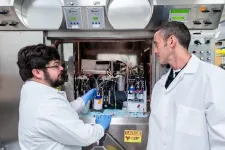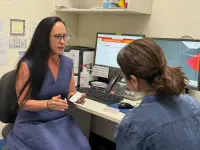(Press-News.org) When mechanical and structural engineers design machines, bridges, and buildings, they calculate loads, stresses, and deformation of metal, steel, concrete, glass, wood, and plastic to find the optimal geometry that bears loads with the minimum cost of material.
Designing for relatively hard materials that do not deform too much is commonly handled by software that calculates and optimizes structures using mathematical models that are well understood and easily applied.
But there is an expanding class of design challenges for things that incorporate soft materials—biological materials, engineered tissues, membranes, and even shape-shifting fluids that respond to electromagnetic fields. Predicting how these soft and fluidic materials respond to forces is more challenging than predicting the behavior of hard materials. Real world applications can include design of artificial hearts and heart valves or robot materials that mimic flesh and soft tissue.
To meet this challenge, a team of Tufts researchers led by Tim Atherton, professor of physics, created Morpho, an open-source programmable environment that enables researchers and engineers to solve shape optimization problems for soft materials. The software recently described in Nature Computational Science is meant to be easy to use, free to use, and applicable to a broad range of scenarios. Among the team developing the software were James Adler, professor of mathematics, and Chaitanya Joshi, postdoctoral scholar in physics.
“Many things that are interesting in science and engineering are shape optimization problems,” said Atherton. That might mean coming up with the best possible contours for a city to accommodate traffic and pedestrians, or the shape of a riverbed with water flowing over it. The question then is, how to make flexible materials that respond in different ways to forces, light, temperature.
“Traditional modeling packages are used for geometric optimization of rigid structures, and are not usually designed to solve shape optimization problems for soft materials,” he said. “Engineers typically have to come up with their own mathematical formulations for soft materials, which can be challenging. Morpho provides a set of tools to help anyone conveniently solve these problems.”
Soft materials have an inherent complexity in their response to their environment. Membranes, for example, can be susceptible to compression, liquid flows, pressure, and vibrations. Particulate material can experience random turbulence when in motion. Their final shape can be very different than their starting point, and less predictable relative to rigid structures.
The Morpho program models the soft materials with a process known as finite elements, mathematically dividing them into small, simple shapes (2D or 3D shapes like triangles or tetrahedrons), while equations modeling material properties, forces, and boundary constraints are generated for each node around the shapes. Then the whole system of equations is solved to predict the optimal shape of the system.
In addition to soft materials, the program can model packing problems as well, whether it’s the flow of granular particles in pharmaceutical manufacturing, coffee, or wine (yes, their properties are due mostly to the particles in these fluids) or how companies can optimally pack and ship products to minimize use of space and packing materials.
Morpho can also model heterogeneous systems, which include both hard and soft components. For example, a cardiovascular stent is a metal mesh surrounded by the soft tissue of the heart and arteries. Researchers can get a better idea of a stent’s expected performance using the Morpho modeling software.
“You don’t really need a lot of training on the program to tackle complex problems,” said Atherton. “I’ve seen undergrads within a couple of weeks of learning Morpho use the package to solve research grade problems, which is amazing.”
END
Tufts scientists develop open-source software for modeling soft materials
The Morpho software can model anything from cardiovascular stents to pharmaceutical ingredient manufacturing
2025-03-05
ELSE PRESS RELEASES FROM THIS DATE:
Repurposed ALS drug becomes imaging probe to help diagnose neurodegeneration
2025-03-05
Positron emission tomography (PET) is a nuclear imaging technique used to diagnose conditions such as cancer. An innovative advance from scientists at St. Jude Children’s Research Hospital is enhancing the technique’s ability to check for signs of neurological disease. The researchers repurposed the drug edaravone, an antioxidant used to treat amyotrophic lateral sclerosis (ALS), as a probe to be used with central nervous system PET imaging. With this technique, the researchers can ...
AI can open up beds in the ICU
2025-03-05
At the height of the COVID-19 pandemic, hospitals frequently ran short of beds in intensive care units. But even earlier, ICUs faced challenges in keeping beds available. With an aging American population, 11% of hospital stays included ICU stays.
Artificial intelligence offers a possible solution, says Indranil Bardhan, professor of information, risk, and operations management and Charles and Elizabeth Prothro Regents Chair in Health Care Management at Texas McCombs. AI models can predict the lengths of time patients will spend in the ICU, helping hospitals better manage their beds and, ideally, cut costs.
But although AI is good at predicting length of stay, ...
Are robotic hernia repairs still in the “learning curve” phase?
2025-03-05
For an abdominal wall hernia repair, also known as a ventral hernia repair, the most common surgical approaches have been laparoscopic and open techniques.
But a new approach for repairing hernias has been steadily growing in popularity: the surgical robot.
Supporters of using the robot method state multiple advantages over traditional laparoscopic and open approaches, including improved surgeon ergonomics.
But there may be downsides to the technology that are going undiscussed.
In a research article published in JAMA Surgery, Brian Fry, M.D., M.S., a ...
New STI impacts 1 in 3 women: Landmark study reveals men are the missing link
2025-03-05
A landmark study reveals that bacterial vaginosis (BV), a condition affecting nearly a third of women worldwide and causing infertility, premature births and newborn deaths, is in fact a sexually transmitted infection (STI), paving the way for a revolution in how it is treated.
Monash University and Alfred Health researchers at the Melbourne Sexual Health Centre say their findings, published today in the New England Journal of Medicine, hold the key to driving down stubborn and distressing recurrence ...
Feeling is believing: Bionic hand “knows” what it’s touching, grasps like a human
2025-03-05
Johns Hopkins University engineers have developed a pioneering prosthetic hand that can grip plush toys, water bottles, and other everyday objects like a human, carefully conforming and adjusting its grasp to avoid damaging or mishandling whatever it holds.
The system’s hybrid design is a first for robotic hands, which have typically been too rigid or too soft to replicate a human’s touch when handling objects of varying textures and materials. The innovation offers a promising solution for people with hand loss and could improve how robotic arms interact with their environment.
Details about the device appear today in Science Advances.
“The ...
Damon Runyon Cancer Research Foundation awards $4.4 million to top young scientists
2025-03-05
The Damon Runyon Cancer Research Foundation has named 13 new Damon Runyon Fellows, exceptional postdoctoral scientists conducting basic and translational cancer research in the laboratories of leading senior investigators. The prestigious, four-year Fellowship encourages the nation's most promising young scientists to pursue careers in cancer research by providing them with independent funding ($300,000 total) to investigate cancer causes, mechanisms, therapies, and prevention.
The Foundation has also named ...
Over-the-counter pain relievers linked to improved recovery from concussion
2025-03-05
EMBARGOED FOR RELEASE UNTIL 4 P.M. ET, WEDNESDAY, MARCH 5, 2025
Media Contacts:
Renee Tessman, rtessman@aan.com, (612) 928-6137
Natalie Conrad, nconrad@aan.com, (612) 928-6164
Over-the-counter pain relievers linked to improved recovery from concussion
MINNEAPOLIS – People who take over-the-counter pain relievers after a concussion may recover faster than those who do not take pain relievers, according to a preliminary study released today, March 5, 2025, that will be presented at the American Academy of Neurology’s 77th Annual Meeting taking place April 5–9, 2025, in San Diego ...
Stressed out? It may increase the risk of stroke
2025-03-05
MINNEAPOLIS — Some people living with chronic stress have a higher risk of stroke, according to a study published on March 5, 2025, online in Neurology®, the medical journal of the American Academy of Neurology. The study looked at younger adults and found an association between stress and stroke, with no known cause, in female participants, but not male participants. This study does not prove that stress causes stroke; it only shows an association.
“Younger people often experience stress due to the demands and pressures associated with work, including long hours and job insecurity, as well as financial burdens,” ...
Nanoscale tweaks help alloy withstand high-speed impacts
2025-03-05
ITHACA, N.Y. – A Cornell University-led collaboration devised a new method for designing metals and alloys that can withstand extreme impacts, which could lead to the development of automobiles, aircraft and armor that can better endure high-speed impacts, extreme heat and stress.
The research, published in Communications Materials, introduces nanometer-scale speed bumps that suppress a fundamental transition that controls how metallic materials deform.
The project was led by Mostafa Hassani, assistant professor of mechanical ...
AI-generated voices which sound like you are perceived as more trustworthy and likeable, with implications for deep-fakes and manipulation
2025-03-05
AI-generated voices which sound like you are perceived as more trustworthy and likeable, with implications for deep-fakes and manipulation
Article URL: https://plos.io/4baFCW5
Article title: AI-determined similarity increases likability and trustworthiness of human voices
Author countries: Germany
Funding: The author(s) received no specific funding for this work. END ...
LAST 30 PRESS RELEASES:
Clearing the brain of aging cells could aid epilepsy and reduce seizures
Brain injuries linked with potential risk of suicide, new study finds
New technique lights up where drugs go in the body, cell by cell
New study finds movement of fishing fleets can reveal shifts in marine ecosystems
Embargoed: New evidence points to potential treatment for vascular dementia
Study uncovers disrupted brain balance in alcohol dependence
Working in groups can help Republicans and Democrats agree on controversial content moderation online
Structural findings reveal how distinct GPCR ligands create different levels of activation
Anything-goes “anyons” may be at the root of surprising quantum experiments
UC review: Maximizing workplace opportunity for veterans
From generation to complex control: Metasurfaces make perfect vortex beams "within reach"
Thin-film lithium niobate-based detector: recent advances and perspectives
Exploring why some people may tend to persistently make bad choices
How cells balance their protein levels
Nirsevimab vs RSVpreF vaccine for RSV–related hospitalization in newborns
Effectiveness and impact of maternal RSV immunization and nirsevimab on medically attended RSV in US children
AI gives scientists a boost, but at the cost of too many mediocre papers
Next-generation vision model maps tree growth at sub-meter precision
Genes aren’t destiny for inherited blindness, study shows
MIT study: High-fat diets make liver cells more likely to become cancerous
Exposure to multiple fine particulate matter components and incident depression in the US Medicare population
Risk of burdensome health care spending over time in the US
Nirsevimab against hospitalizations and emergency department visits for lower respiratory tract infection in infants
New microfluidics technology enables highly uniform DNA condensate formation
A new strategy for immune tolerance
Super Mario Bros. help fight burnout: New study links classic games to boosted happiness
Deepest gas hydrate cold seep ever discovered in the arctic: International research team unveils Freya Hydrate Mounds at 3,640 m depth.
Integrating light and structure: Smarter mapping for fragile wetland ecosystems
ACA-SIM: A robust way to decode satellite signals over complex waters
Probiotics can restore gut microbiome in breastfed infants
[Press-News.org] Tufts scientists develop open-source software for modeling soft materialsThe Morpho software can model anything from cardiovascular stents to pharmaceutical ingredient manufacturing



